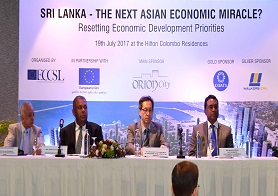 Minister of Finance & Media mentioned this while addressing the participants during a conference organized by the European Chamber of Commerce of Sri Lanka (19th July 2017) held at the JAIC Hilton.
Minister of Finance & Media mentioned this while addressing the participants during a conference organized by the European Chamber of Commerce of Sri Lanka (19th July 2017) held at the JAIC Hilton.The full text of his speech
I am deeply humbled by the invitation to speak a few words at this very timely conference jointly organized by the European Chamber of Commerce and the European Delegation to Sri Lanka.
Ladies and Gentlemen, the notion of ‘envisioning an export oriented economy’ in fact goes back centuries in the context of Sri Lanka’s experience in international economic relations with the rest of the world
Even considering modern history, during early 1960s exports accounted for over 25% of GDP. However, it fell gradually to 12% in the early 1970s. The economic liberalization policies of 1977 resulted in exports reaching 30% of GDP in the late ‘70s and the second wave of reforms in the early 1990s helped exports peak at 33% of GDP in the year 2000.
Since then, exports relative to GDP fell continuously to below 13% by 2016. Sri Lanka is now less open and economically integrated today than it was three decades ago.
In the last decade, especially since the mid-2000s, there has been a noticeable orientation towards protectionism, as the country’s industrial policy focused more on promoting domestic enterprises. There has been an increase in para-tariffs which have not only significantly increased nominal protection and prices of imports, but has also added more complexity to trade policy.
Further, most of infrastructure investments funded by external borrowings have been directed towards the non-tradable sector. These borrowings created foreign currency liabilities, without the necessary foreign currency inflows.
Ladies and Gentlemen, the economic development model that the country experimented in the recent decade needs to change, as it relied entirely on domestic demand for growth. For an economy like ours, we need to tap into external sources of demand through trade and FDI in order to attain sustained GDP growth levels of 7% and above.
Let me now touch on some of the policies that the government intends to implement in order to engineer this shift in economic trajectory.
Sound macroeconomic policies form the bedrock of a robust trade and investment regime. In the past Sri Lanka has relied on open ended tax incentives which have resulted in large fiscal losses with limited translation into real FDI growth. In 2016, the foregone taxes arising from tax incentives and preferential rates amounted to around US$ 1.4 bn or 1.6% of GDP – well above the annual FDI received.
This is one of the factors that has led to weakness in generation of direct taxes and resulted in 80% of taxes being collected in the form of regressive indirect taxes, which result in an uneven burden on the poor.
Therefore, we must look at new ways of driving investment. We will look at minimizing the upfront costs of investment, and introduce innovative schemes such as accelerated depreciation, which will better target the actual investment outlay.
The government recognizes the fact that historically, shortcomings in policy stability have been an important factor in FDI weakness in particular. Thus a key commitment of government fiscal policy is to provide a stable policy regime, with simpler, clear, and more transparent tax policy that provides investors with a clear understanding of the policy space they operate in.
The government will continue to mobilize investments in logistics and transport infrastructure, specially sea-ports and airports, in order to support trade and investment. In addition, institutional reforms will continue to take forward Sri Lanka’s commitment towards enhancing Trade Facilitation measures.
Investment in human capital is equally, if not more important, than investment in physical infrastructure in order to drive a competitive export led economy. Thus further resources will be allocated towards strengthening education, training, and research capabilities in the country.
ThLadies and Gentlemen, let me now present to you some major economic reform areas that the government aims to implement to shape Sri Lanka’s economic outlook in the coming years. I would like to highlight three reform areas, among others.
First, Fiscal Consolidation and Revenue Mobilization Reforms. We are in the final stages of introducing new legislation for the Inland Revenue Department. We are in the first year of implementation of the Revenue Administration and Management Information System (RAMIS), aimed at increasing automation and enhancing the efficiency of tax administration. We are also in the final stages of implementation of the Integrated Treasury Management Information System (ITMIS) to facilitate robust government payments systems.
We are already seeing the results of some of measures implemented so far. For instance, in 2016, government revenue increased to 14.2 percent of GDP, a notable improvement from 11.5 percent of GDP in 2014. The fiscal deficit has been curtailed to 5.4 percent of GDP in 2016.
Second, Reforms to Trade and Investment Regime. We are continuing the modernization of trade policies by rationalization of tariff and non-tariff barriers to trade, with a view to reducing the complexity of taxation and enhancing the ease of doing business.
Gradually as we shift towards a 60:40 ratio of direct to indirect taxes, we can reduce our reliance on taxes collected at the border, enabling more outward-orientation of the economy.
Third, legal and judicial reforms. Sri Lanka needs to update commercial laws and procedures to enhance its investment climate. Therefore, identifying and implementing the legislative reforms and changes in ‘subordinate legislations’ is a major priority for the government.
Of key relevance to trade and investment would be the Foreign Exchange Management Bill and the Customs Act, which are important areas for reform.
In conclusion, the way forward for Sri Lanka would be to attract export oriented FDI that connects local value chains to global value chains. This would be the foundation for trade and economic diversification over the medium-term.
Such FDI not only boosts investment necessary for growth through new technology and access to markets, it also provides crucial non-debt creating balance of payments financing. Building on that, the economy could gradually enhance its technical capabilities, enabling Sri Lanka to enter into global value chains, creating opportunities across the entire economy.
Your Excellencies, Ladies and Gentlemen, let me reiterate my gratitude to the organizers of this important event, and I wish you all a very successful conference!












